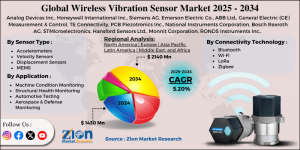Global Wireless Vibration Sensor Market Size to Reach $2.14 Billion by 2034, Growing at 5.2% CAGR
The global wireless vibration sensor market size was worth around USD 1430 million in 2024 and is predicted to grow to around USD 2140 million by 2034
The global wireless vibration sensor market size was worth around USD 1430 million in 2024 and is predicted to grow to around USD 2140 million by 2034, (CAGR) of roughly 5.20% between 2025 and 2034.”
PUNE, MAHARASHTRA, INDIA, August 18, 2025 /EINPresswire.com/ -- Global Wireless Vibration Sensor Market Research Report (2024–2034): Regional Insights, Segmentation, and Competitive Landscape— Deepak Rupnar
Market Overview
The global wireless vibration sensor market Size was valued at approximately USD 1,430 million in 2024 and is expected to reach around USD 2,140 million by 2034, growing at a CAGR of 5.20% between 2025 and 2034.
Access key findings and insights from our Report in this sample - https://www.zionmarketresearch.com/sample/wireless-vibration-sensor-market
Wireless vibration sensors are crucial in condition monitoring and predictive maintenance systems across industries such as manufacturing, oil & gas, automotive, aerospace, energy, and utilities. These sensors detect changes in vibration levels in machinery and equipment, providing early warnings of potential failures. By eliminating the need for wired connections, they offer greater flexibility, cost-effectiveness, and real-time monitoring capabilities.
The market is experiencing steady growth driven by the rise of Industrial IoT (IIoT), increasing focus on predictive maintenance, and the growing demand for wireless sensor networks in smart factories.
Key Insights:
As per the analysis shared by our research analyst, the global wireless vibration sensor market is estimated to grow annually at a CAGR of around 5.20% over the forecast period (2025-2034)
In terms of revenue, the global wireless vibration sensor market size was valued at around USD 1430 million in 2024 and is projected to reach USD 2140 million by 2034.
The wireless vibration sensor market is projected to grow significantly owing to the surging adoption of predictive maintenance, cost reduction in sensor deployment, and growth in smart grid deployment and renewable energy.
Based on sensor type, the accelerometers segment is expected to lead the market, while the MEMS segment is expected to grow considerably.
Based on connectivity technology, the Wi-Fi is the dominant segment, while the Bluetooth segment is projected to witness sizable revenue growth over the forecast period.
Based on application, the predictive maintenance segment is expected to lead the market compared to the machine condition monitoring segment.
Based on region, North America is projected to dominate the global market during the estimated period, followed by Europe.
Key Market Drivers
Increasing Demand for Predictive Maintenance
Industries are shifting from traditional maintenance to predictive models that rely on vibration monitoring to prevent costly downtime.
Adoption of Industrial IoT (IIoT) & Smart Manufacturing
Wireless vibration sensors are a critical part of IIoT ecosystems, enabling machine-to-machine communication and real-time performance monitoring.
Cost-Effectiveness & Flexibility of Wireless Systems
Wireless systems reduce wiring costs, simplify installation, and allow scalability, making them attractive for industries with complex operations.
Rising Focus on Worker Safety
Continuous equipment monitoring reduces the risk of sudden breakdowns, ensuring safer working environments.
Do You Have Any Query Or Specific Requirement? Request Customization of Report: https://www.zionmarketresearch.com/custom/9607
Market Challenges
Data Security Concerns in wireless communication networks.
Battery Life Limitations for long-term deployment.
High Initial Investment for large-scale industrial integration.
Future Opportunities
Integration with AI and machine learning for advanced predictive analytics.
Adoption in renewable energy plants such as wind and solar farms.
Expansion into remote monitoring in harsh environments (offshore oil rigs, mining).
Growth of 5G-enabled wireless sensors for faster, more reliable communication.
Regional Market Analysis
1. North America
2024 Market Size: USD 520 million
2034 Market Size: USD 760 million
CAGR (2025–2034): ~3.9%
North America leads due to strong industrial automation adoption, widespread use of predictive maintenance, and major presence of wireless sensor manufacturers. The U.S. dominates, particularly in oil & gas, aerospace, and automotive industries.
2. Europe
2024 Market Size: USD 370 million
2034 Market Size: USD 570 million
CAGR (2025–2034): ~4.4%
Europe is a significant market, with Germany, the UK, and France driving adoption. Growth is supported by advanced manufacturing industries, Industry 4.0 initiatives, and energy efficiency regulations.
3. Asia-Pacific (APAC)
2024 Market Size: USD 330 million
2034 Market Size: USD 570 million
CAGR (2025–2034): ~5.7%
APAC is the fastest-growing market due to rapid industrialization, expansion of manufacturing hubs in China and India, and government-backed smart factory projects. Japan and South Korea are also key markets, leveraging advanced automation technologies.
4. Latin America
2024 Market Size: USD 120 million
2034 Market Size: USD 180 million
CAGR (2025–2034): ~4.1%
Latin America is adopting wireless vibration sensors mainly in oil & gas, mining, and energy sectors. Brazil and Mexico are leading markets, supported by digital transformation in industrial operations.
5. Middle East & Africa (MEA)
2024 Market Size: USD 90 million
2034 Market Size: USD 160 million
CAGR (2025–2034): ~5.9%
MEA is showing steady growth due to rising oil & gas exploration activities and the adoption of wireless monitoring in the energy sector. GCC countries, especially Saudi Arabia and UAE, are key contributors.
Segmentation Analysis
By Technology
Wi-Fi–based Sensors – Widely used due to network availability.
Bluetooth Low Energy (BLE) Sensors – Popular for low power consumption and short-range monitoring.
Zigbee & WirelessHART Sensors – Preferred for industrial-grade reliability.
Other Wireless Protocols (5G, LoRaWAN, NB-IoT) – Emerging for long-range and high-speed data transmission.
By Application
Condition Monitoring – Largest share; essential in predictive maintenance.
Machine Health Monitoring – Increasing adoption across factories.
Structural Health Monitoring – Used in bridges, railways, and aerospace.
Energy & Utilities Monitoring – Growing adoption in power plants and renewables.
By End-Use Industry
Manufacturing – Dominant segment with wide use in production plants.
Oil & Gas – High adoption in offshore rigs, refineries, and pipelines.
Automotive & Aerospace – Growing due to precision equipment monitoring.
Energy & Power – Increasing use in wind turbines, solar plants, and nuclear power stations.
Others (Mining, Construction, Healthcare) – Niche applications with growth potential.
Request Free Brochure-https://www.zionmarketresearch.com/requestbrochure/wireless-vibration-sensor-market
Competitive Landscape
The market is moderately fragmented, with companies focusing on R&D, wireless innovations, and strategic partnerships.
Key Players
Emerson Electric Co. – Leader in industrial IoT and wireless vibration monitoring solutions.
Siemens AG – Offers advanced wireless condition monitoring systems.
Honeywell International Inc. – Strong presence in industrial automation and predictive maintenance.
SKF Group – Specializes in condition monitoring and wireless vibration analysis tools.
General Electric (GE) Digital – Provides IIoT-enabled monitoring solutions.
Analog Devices Inc. – Develops advanced MEMS-based wireless sensors.
ABB Ltd. – Focused on automation solutions integrated with wireless sensing technologies.
National Instruments (NI) – Strong in data acquisition and wireless vibration analysis.
KCF Technologies, Inc. – Emerging player with innovative wireless sensor networks.
Strategies Adopted
Technological Advancements – Focus on low-power, AI-enabled, and 5G-compatible sensors.
Partnerships & Collaborations – Companies are working with industrial automation providers for integration.
Geographic Expansion – Targeting fast-growing regions like APAC and MEA.
Product Customization – Tailored solutions for industries such as oil & gas, manufacturing, and energy.
Conclusion
The global wireless vibration sensor market is set for steady growth, reaching USD 2.14 billion by 2034.
North America and Europe remain the largest markets, driven by industrial automation and predictive maintenance.
Asia-Pacific will lead in growth rate, thanks to large-scale manufacturing expansion and IIoT adoption.
Segments such as condition monitoring, manufacturing, and energy sectors will dominate adoption.
The next decade will see wireless vibration sensors evolve with AI, machine learning, and 5G integration, unlocking new possibilities in predictive maintenance and smart factories worldwide.
Browse Other Related Research Reports from Zion Market Research
Hydraulic Breaker Market By Application (Demolition, Trenching, Breaking Oversized Materials, and Others), By Equipment Size (Large, Small, and Medium), By End-User Industry (Mining, Construction, and Others), By Type (Non-Premium and Premium), and By Region - Global and Regional Industry Overview, Market Intelligence, Comprehensive Analysis, Historical Data, and Forecasts 2024 - 2032-https://www.zionmarketresearch.com/report/hydraulic-breaker-market
Storage Tank Market By End-User Industry (Oil & Gas, Food & Beverages, Paper & Pulp, Power Generation, Water & Wastewater Management, and Others), By Material Type (FRP, Metal, Plastic, and Others), and By Region - Global and Regional Industry Overview, Market Intelligence, Comprehensive Analysis, Historical Data, and Forecasts 2024 - 2032-https://www.zionmarketresearch.com/report/storage-tank-market
Pollution Absorbing Bricks Market By Product (Clay and Concrete), By Application (Non-Structural and Structural), By End-User (Non-Residential Sector and Residential Sector), and By Region - Global and Regional Industry Overview, Market Intelligence, Comprehensive Analysis, Historical Data, and Forecasts 2024-2032-https://www.zionmarketresearch.com/report/pollution-absorbing-bricks-market
Chainsaw Market By Product Type (Fuel-Operated and Electric-Operated), By Application (Commercial and Residential), and By Region - Global and Regional Industry Overview, Market Intelligence, Comprehensive Analysis, Historical Data, and Forecasts 2024 - 2032-https://www.zionmarketresearch.com/report/chainsaw-market
Spray Painting Machine Market By Type (Airless Spraying Machines, HVLP Spraying Machines, and LVLP Spraying), By Application (Wood Furniture Industry, Automotive Industry, Aerospace Industry, Construction Industry, Food & Beverage Equipment Manufacturing Industry, and Others), and By Region - Global and Regional Industry Overview, Market Intelligence, Comprehensive Analysis, Historical Data, and Forecasts 2024 - 2032-https://www.zionmarketresearch.com/report/spray-painting-machine-market
Digital Twins in Manufacturing Market By Enterprise Size (Small & Medium Enterprises (SMEs) and Large Enterprises), By Application (Predictive Maintenance, Performance Monitoring, Product Design & Development, Business Optimization, and Others), and By Region - Global and Regional Industry Overview, Market Intelligence, Comprehensive Analysis, Historical Data, and Forecasts 2024 - 2032-https://www.zionmarketresearch.com/report/digital-twins-in-manufacturing-market
Demister Market By Type (Wire-mesh Demister and Baffle-type Demister), By Application (Petrochemical, Chemicals, Power, and Gas Processing), and By Region - Global and Regional Industry Overview, Market Intelligence, Comprehensive Analysis, Historical Data, and Forecasts 2024 - 2032-https://www.zionmarketresearch.com/report/demister-market
Industrial Hydraulic Equipment Market By Component (Motors, Cylinders, Filters, Pumps, and Valves), By End-User (Aerospace, Construction, Agriculture, Metal & Machinery Manufacturing, and Automotive), and By Region - Global and Regional Industry Overview, Market Intelligence, Comprehensive Analysis, Historical Data, and Forecasts 2024 - 2032-https://www.zionmarketresearch.com/report/industrial-hydraulic-equipment-market
Track Laying Equipment Market By Equipment Type (Track Laying Machines, Rail Grinding Machines, Sleeper Laying Machines, Ballast Tamping Machines, Rail Welding Machines, and Track Inspection Vehicles), By Technology (Manual, Fully Automated, and Semi-Automated), By Application (New Track Construction, Track Renewal, and Track Maintenance), By End-User (Equipment Rental Firms, Railway Authorities, and Railway Contractors), and By Region - Global and Regional Industry Overview, Market Intelligence, Comprehensive Analysis, Historical Data, and Forecasts 2024 - 2032-https://www.zionmarketresearch.com/report/track-laying-equipment-market
Deepak Rupnar
Zion Market Research
+1 855-465-4651
richard@zionmarketresearch.com
Visit us on social media:
LinkedIn
Instagram
Facebook
YouTube
X
Legal Disclaimer:
EIN Presswire provides this news content "as is" without warranty of any kind. We do not accept any responsibility or liability for the accuracy, content, images, videos, licenses, completeness, legality, or reliability of the information contained in this article. If you have any complaints or copyright issues related to this article, kindly contact the author above.



